2019 HONDA CLARITY FUEL CELL stop start
[x] Cancel search: stop startPage 373 of 551
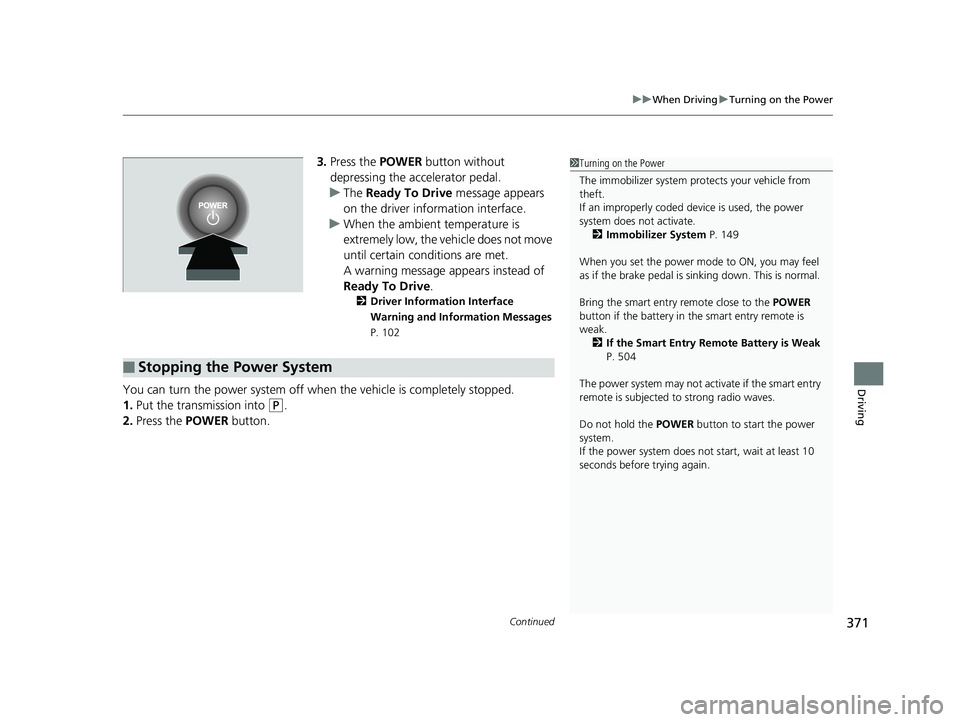
Continued371
uuWhen Driving uTurning on the Power
Driving
3. Press the POWER button without
depressing the accelerator pedal.
u The Ready To Drive message appears
on the driver info rmation interface.
u When the ambient temperature is
extremely low, the vehicle does not move
until certain conditions are met.
A warning message appears instead of
Ready To Drive .
2Driver Information Interface
Warning and Information Messages
P. 102
You can turn the power system off when the vehicle is completely stopped.
1. Put the transmission into
(P.
2. Press the POWER button.
1Turning on the Power
The immobilizer system pr otects your vehicle from
theft.
If an improperly coded de vice is used, the power
system does not activate. 2 Immobilizer System P. 149
When you set the power mode to ON, you may feel
as if the brake pedal is sinking down. This is normal.
Bring the smart entry remote close to the POWER
button if the battery in the smart entry remote is
weak.
2 If the Smart Entry Remote Battery is Weak
P. 504
The power system may not activate if the smart entry
remote is subjected to strong radio waves.
Do not hold the POWER button to start the power
system.
If the power system does not start, wait at least 10
seconds before trying again.
■Stopping the Power System
19 CLARITY FCV CSS-31TRT6200.book 371 ページ 2019年1月17日 木曜日 午前11 時54分
Page 396 of 551
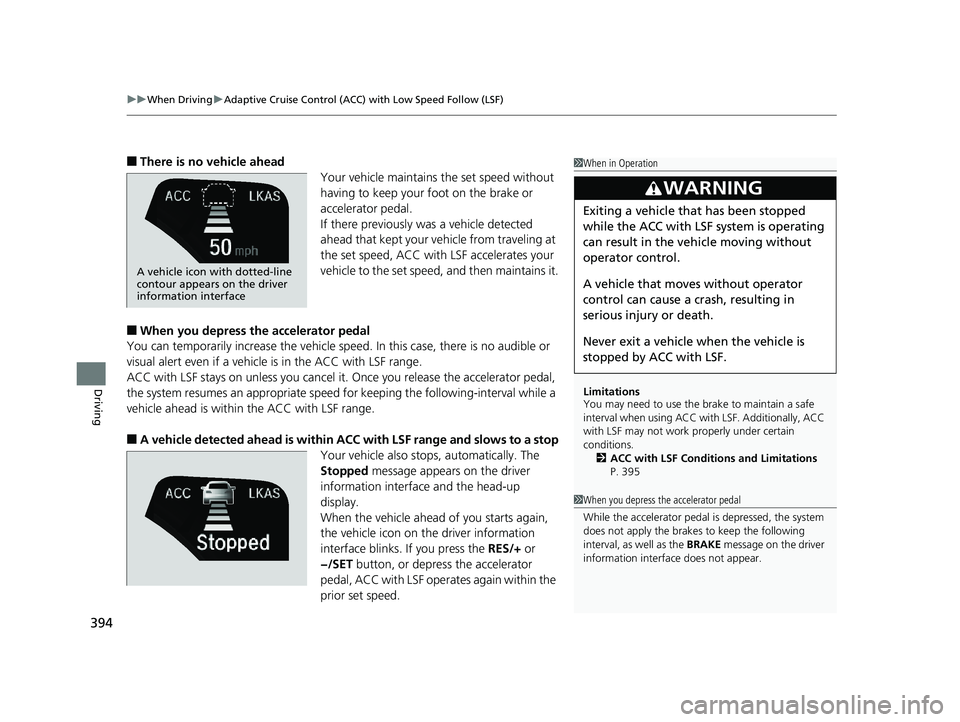
uuWhen Driving uAdaptive Cruise Control (ACC) with Low Speed Follow (LSF)
394
Driving
■There is no vehicle ahead
Your vehicle maintains the set speed without
having to keep your foot on the brake or
accelerator pedal.
If there previously was a vehicle detected
ahead that kept your vehicle from traveling at
the set speed, ACC with LSF accelerates your
vehicle to the set speed, and then maintains it.
■When you depress the accelerator pedal
You can temporarily increase th e vehicle speed. In this case, there is no audible or
visual alert even if a vehicle is in the ACC with LSF range.
ACC with LSF stays on unless you cancel it. Once you release the accelerator pedal,
the system resumes an appropriate speed for keeping the following-interval while a
vehicle ahead is within the ACC with LSF range.
■A vehicle detected ahead is within AC C with LSF range and slows to a stop
Your vehicle also stop s, automatically. The
Stopped message appears on the driver
information interface and the head-up
display.
When the vehicle ahead of you starts again,
the vehicle icon on th e driver information
interface blinks. If you press the RES/+ or
−/SET button, or depress the accelerator
pedal, ACC with LSF operates again within the
prior set speed.
1 When in Operation
Limitations
You may need to use the brake to maintain a safe
interval when using ACC wi th LSF. Additionally, ACC
with LSF may not work properly under certain
conditions. 2 ACC with LSF Conditions and Limitations
P. 395
3WARNING
Exiting a vehicle that has been stopped
while the ACC with LSF system is operating
can result in the ve hicle moving without
operator control.
A vehicle that moves without operator
control can cause a crash, resulting in
serious injury or death.
Never exit a vehicle when the vehicle is
stopped by ACC with LSF.
A vehicle icon with dotted-line
contour appears on the driver
information interface
1 When you depress the accelerator pedal
While the accelerator pedal is depressed, the system
does not apply the brakes to keep the following
interval, as well as the BRAKE message on the driver
information interface does not appear.
19 CLARITY FCV CSS-31TRT6200.book 394 ページ 2019年1月17日 木曜日 午前11 時54分
Page 411 of 551
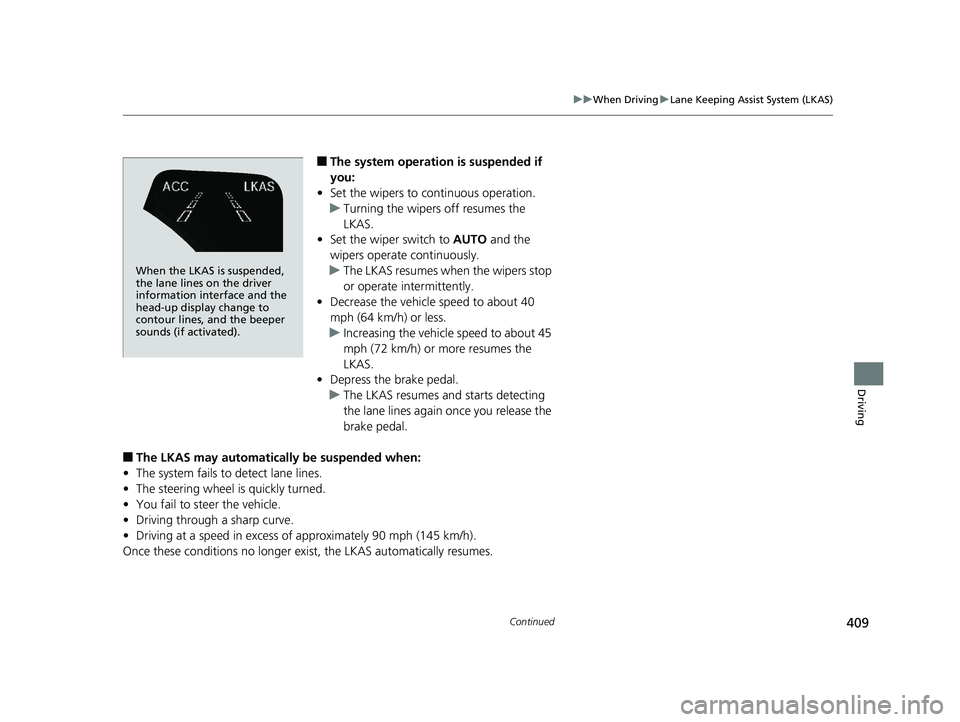
409
uuWhen Driving uLane Keeping Assist System (LKAS)
Continued
Driving
■The system operation is suspended if
you:
• Set the wipers to continuous operation.
u Turning the wipers off resumes the
LKAS.
• Set the wiper switch to AUTO and the
wipers operate continuously.
u The LKAS resumes when the wipers stop
or operate intermittently.
• Decrease the vehicle speed to about 40
mph (64 km/h) or less.
u Increasing the vehicle speed to about 45
mph (72 km/h) or more resumes the
LKAS.
• Depress the brake pedal.
u The LKAS resumes and starts detecting
the lane lines again once you release the
brake pedal.
■The LKAS may automatica lly be suspended when:
• The system fails to detect lane lines.
• The steering wheel is quickly turned.
• You fail to steer the vehicle.
• Driving through a sharp curve.
• Driving at a speed in excess of approximately 90 mph (145 km/h).
Once these conditions no longer exist, the LKAS automatically resumes.
When the LKAS is suspended,
the lane lines on the driver
information interface and the
head-up display change to
contour lines, and the beeper
sounds (if activated).
19 CLARITY FCV CSS-31TRT6200.book 409 ページ 2019年1月17日 木曜日 午前11 時54分
Page 417 of 551

415
uuWhen Driving uTire Pressure Monitoring System (TPMS)
Continued
Driving
Tire Pressure Monitoring System (TPMS)
Instead of directly measuring the pressure in each tire, the TPMS on this vehicle
monitors and compares the rolling radius and rotational characteristics of each
wheel and tire while you are driving to determine if one or more tires are
significantly under-inflated. This will caus e the low tire pressure/TPMS indicator to
come on and a message to appear on the driver information interface.
You must start TPMS calibration every time you:
• Adjust the pressure in one or more tires.
• Rotate the tires.
• Replace one or more tires.
Before calibrating the TPMS:
• Set the cold tire pressure in all four tires.
2 Checking Tires P. 468
Make sure:
•The vehicle is at a complete stop.
• The gear position is in
(P.
• The power mode is in ON.
■TPMS Calibration
1Tire Pressure Monitoring System (TPMS)
The system does not monitor the tires when driving
at low speed.
Conditions such as low ambient temperature and
altitude change directly a ffect tire pressure and can
trigger the low tire pressure/TPMS indicator to come on.
Tire pressure checked and inflated in:
•Warm weather can beco me under-inflated in
colder weather.
•Cold weather can become over-inflated in warmer
weather.
The low tire pressure/TPMS indicator will not come
on as a result of over inflation.
The TPMS may not function pr operly if tire type and
size are mixed. Make sure to use the same size and
type of tire. 2 Checking and Maintaining Tires P. 468
The low tire pressure/TPMS indicator may come on
with a delay or may not come on at all when:
•You rapidly accelerate, decelerate, or turn the
steering wheel.
•You drive on snowy or slippery roads.
•Tire chains are used.
The low tire pressure/TPMS indicator may come on
under the following conditions:
•There is a heavier and uneve n load on the tires than
the condition at calibration.
•Tire chains are used.
19 CLARITY FCV CSS-31TRT6200.book 415 ページ 2019年1月17日 木曜日 午前11 時54分
Page 422 of 551
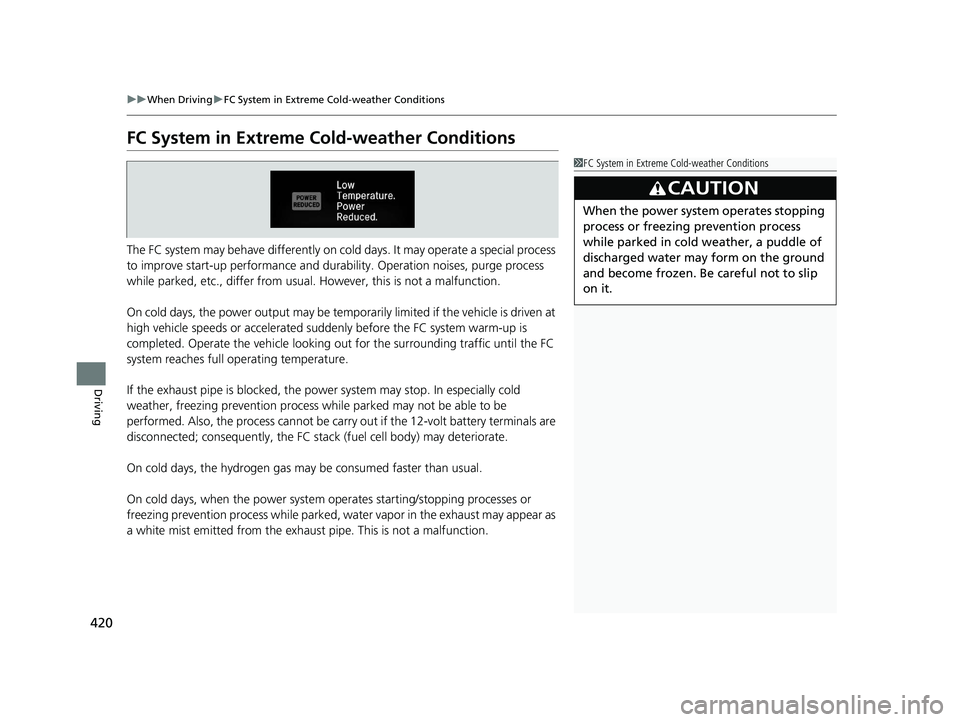
420
uuWhen Driving uFC System in Extreme Cold-weather Conditions
Driving
FC System in Extreme Cold-weather Conditions
The FC system may behave differently on cold days. It may operate a special process
to improve start-up performance and dura bility. Operation noises, purge process
while parked, etc., differ from usual. However, this is not a malfunction.
On cold days, the power output may be temporarily limited if the vehicle is driven at
high vehicle speeds or accelerated suddenly before the FC system warm-up is
completed. Operate the vehi cle looking out for the surrounding traffic until the FC
system reaches full ope rating temperature.
If the exhaust pipe is blocked, the power system may stop. In especially cold
weather, freezing prevention process wh ile parked may not be able to be
performed. Also, the process cannot be carry out if the 12-volt battery terminals are
disconnected; consequently, the FC st ack (fuel cell body) may deteriorate.
On cold days, the hydrogen gas may be consumed faster than usual.
On cold days, when the power system op erates starting/stopping processes or
freezing prevention process while parked, wa ter vapor in the exhaust may appear as
a white mist emitted from the exhaus t pipe. This is not a malfunction.
1FC System in Extreme Cold-weather Conditions
3CAUTION
When the power system operates stopping
process or freezing prevention process
while parked in cold weather, a puddle of
discharged water may form on the ground
and become frozen. Be careful not to slip
on it.
19 CLARITY FCV CSS-31TRT6200.book 420 ページ 2019年1月17日 木曜日 午前11 時54分
Page 423 of 551
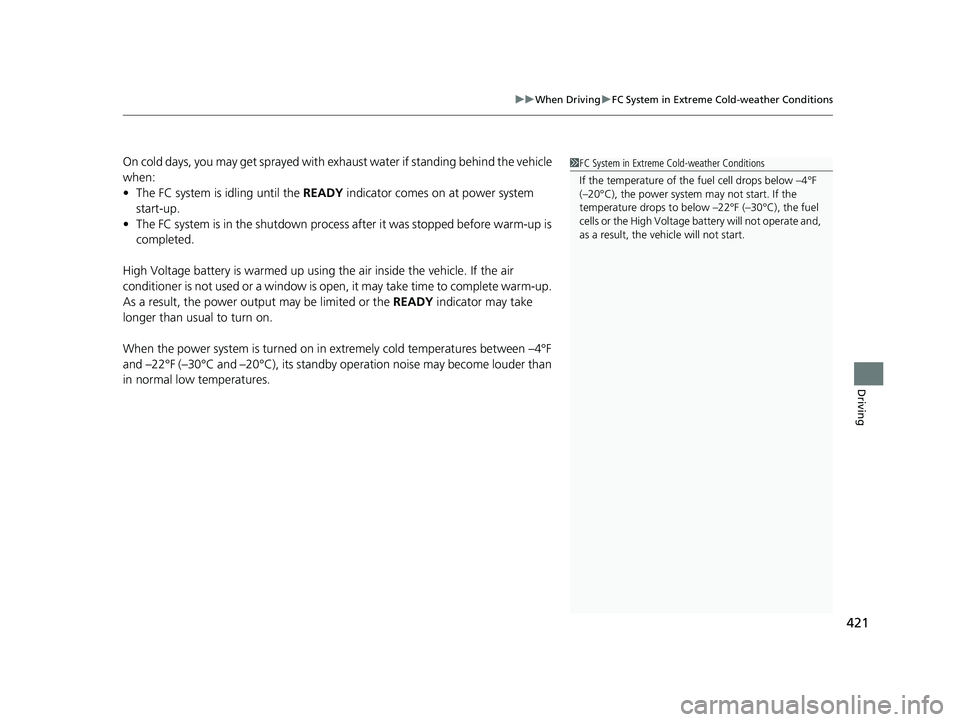
421
uuWhen Driving uFC System in Extreme Cold-weather Conditions
Driving
On cold days, you may get sprayed with exhaust water if standing behind the vehicle
when:
• The FC system is idling until the READY indicator comes on at power system
start-up.
• The FC system is in the shutdown process after it was stopped before warm-up is
completed.
High Voltage battery is warmed up using the air inside the vehicle. If the air
conditioner is not used or a window is op en, it may take time to complete warm-up.
As a result, the power output may be limited or the READY indicator may take
longer than usual to turn on.
When the power system is tu rned on in extremely cold temperatures between –4°F
and –22°F (–30°C and –20°C), its standby operation noise may become louder than
in normal low temperatures.1 FC System in Extreme Cold-weather Conditions
If the temperature of the fuel cell drops below –4°F
(–20°C), the power system may not start. If the
temperature drops to belo w –22°F (–30°C), the fuel
cells or the High Voltage ba ttery will not operate and,
as a result, the vehicle will not start.
19 CLARITY FCV CSS-31TRT6200.book 421 ページ 2019年1月17日 木曜日 午前11 時54分
Page 426 of 551
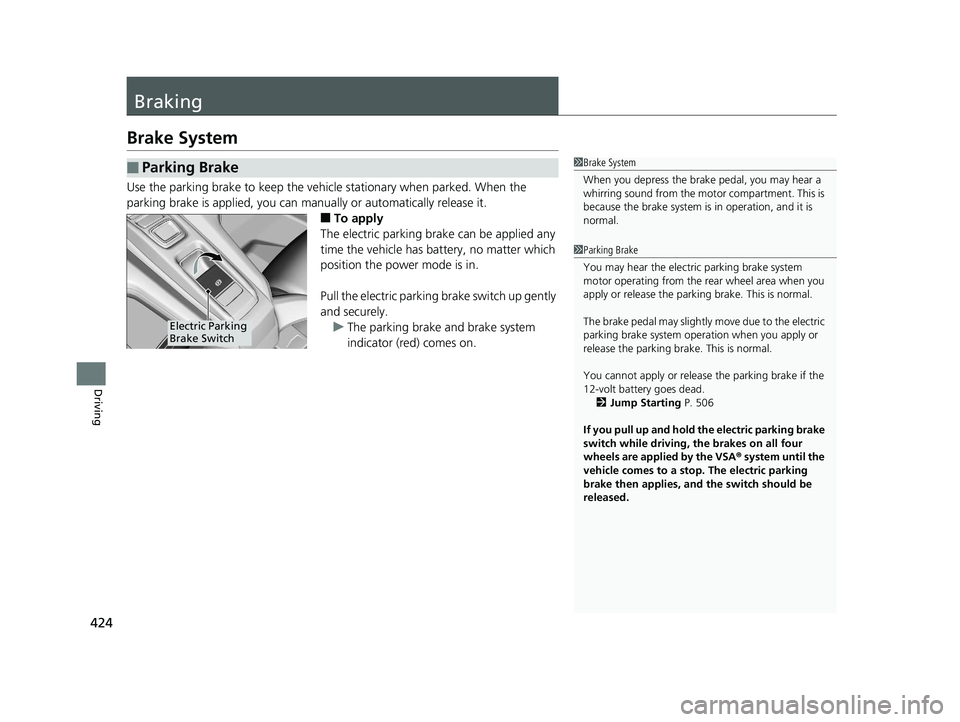
424
Driving
Braking
Brake System
Use the parking brake to keep the vehicle stationary when parked. When the
parking brake is applied, you can manually or automatically release it.
■To apply
The electric parking brake can be applied any
time the vehicle has battery, no matter which
position the power mode is in.
Pull the electric parkin g brake switch up gently
and securely.
u The parking brake and brake system
indicator (red) comes on.
■Parking Brake1Brake System
When you depress the brak e pedal, you may hear a
whirring sound from the motor compartment. This is
because the brake system is in operation, and it is
normal.
1 Parking Brake
You may hear the electric parking brake system
motor operating from the re ar wheel area when you
apply or release the parki ng brake. This is normal.
The brake pedal may slightly move due to the electric
parking brake system opera tion when you apply or
release the parking br ake. This is normal.
You cannot apply or release the parking brake if the
12-volt battery goes dead. 2 Jump Starting P. 506
If you pull up and hold the electric parking brake
switch while driving, the brakes on all four
wheels are applied by the VSA ® system until the
vehicle comes to a stop. The electric parking
brake then applies, and the switch should be
released.
Electric Parking
Brake Switch
19 CLARITY FCV CSS-31TRT6200.book 424 ページ 2019年1月17日 木曜日 午前11 時54分
Page 427 of 551
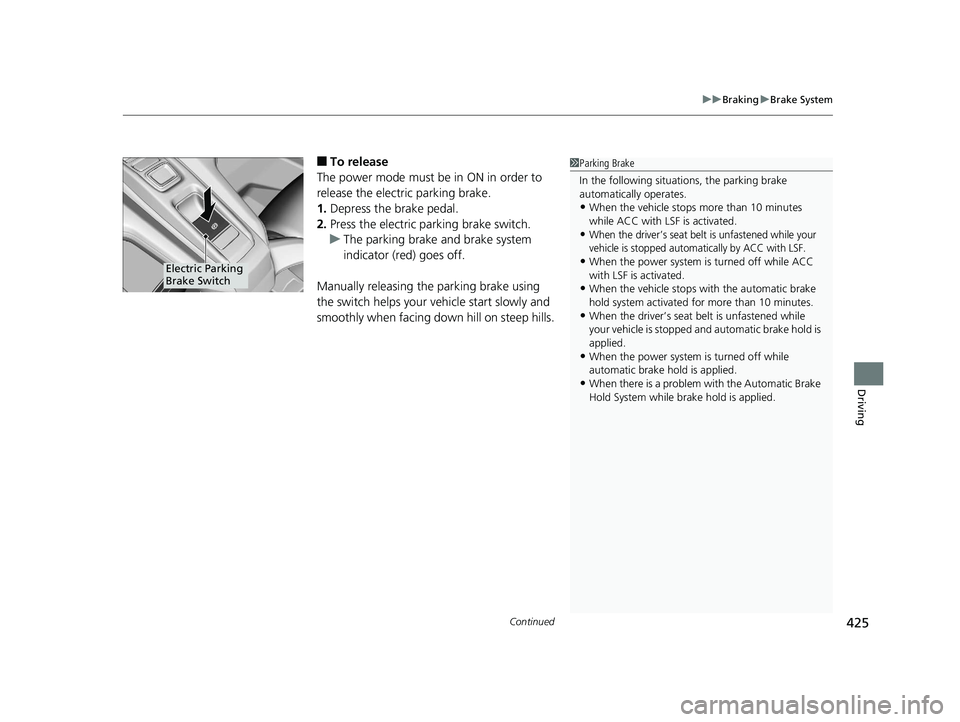
Continued425
uuBraking uBrake System
Driving
■To release
The power mode must be in ON in order to
release the electric parking brake.
1. Depress the brake pedal.
2. Press the electric parking brake switch.
u The parking brake and brake system
indicator (red) goes off.
Manually releasing the parking brake using
the switch helps your vehicle start slowly and
smoothly when facing down hill on steep hills.1 Parking Brake
In the following situations, the parking brake
automatically operates.
•When the vehicle stops more than 10 minutes
while ACC with LSF is activated.
•When the driver’s seat belt is unfastened while your
vehicle is stopped automatically by ACC with LSF.
•When the power system is turned off while ACC
with LSF is activated.
•When the vehicle stops with the automatic brake
hold system activated for more than 10 minutes.
•When the driver’s seat belt is unfastened while
your vehicle is stopped a nd automatic brake hold is
applied.
•When the power system is turned off while
automatic brake hold is applied.
•When there is a problem with the Automatic Brake
Hold System while brake hold is applied.
Electric Parking
Brake Switch
19 CLARITY FCV CSS-31TRT6200.book 425 ページ 2019年1月17日 木曜日 午前11 時54分